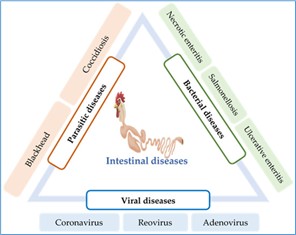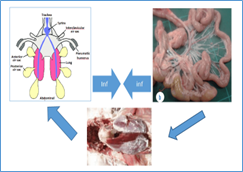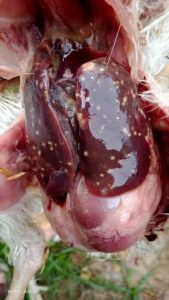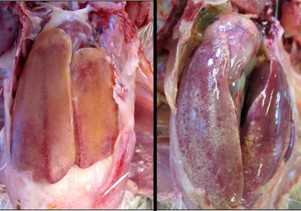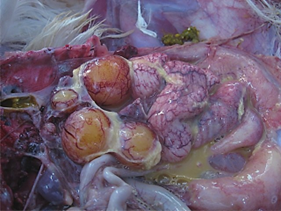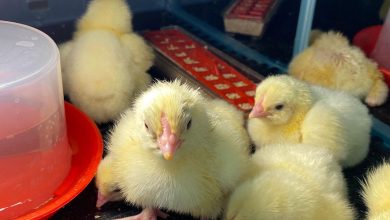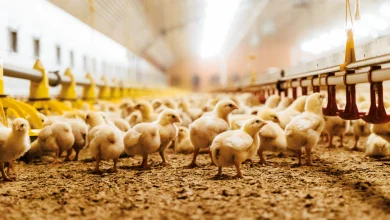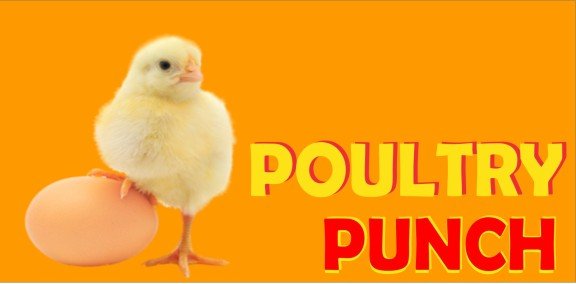Bidirectional Spread of Gut Infections to other Organs in Poultry
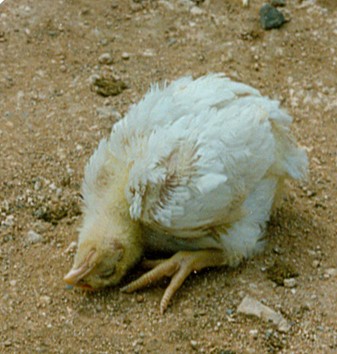
Bidirectional Spread of Gut Infections to other Organs in Poultry
Prof.Dr.R.N.Sreenivas Gowda*
Introduction
The digestive tract of vertebrate animals is complex and has evolved to serve its primary function of supplying nutrients to the host animal, while at the same time serving as a barrier to infection and harm from compounds within the digestive tract. It is also called as gastrointestinal (GI) tract, the lining of which is the largest surface of an animal’s body that faces the external environment, has been considered as a sensory organ. It is commonly referred as GUT. The intestine is responsible for facilitating the digestion and absorption of nutrients. It is the largest immune organ in the body, plays an invaluable role in sustaining normal immune defense (GALT-Gut Associated Lymphoid Tissue). The gut is currently assumed to play a central role in sustaining the normal function of other organs and in the pathogenesis of many diseases.
Why is it called gut?
Meaning in old English guttas (plural) “bowels, entrails,” literally “a channel,” related to geotan “to pour,” from Proto-Germanic *gut-, from PIE root *gheu- “to pour.” Related to Middle Dutch gote, Dutch goot, German Gosse “gutter, drain,” Middle English gote “channel, stream.” Meaning “abdomen,/ belly” .
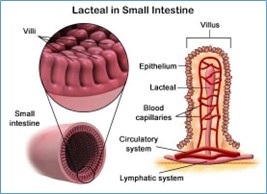
Evidence from recent research studies describes bidirectional interactions between the gut microbiota and other organs, providing theoretical support for an integrated model that integrates with multiple organs and immune system. The common interaction with organs are: Gut-skin Axis, Gut–Brain Axis, Gut–Lung Axis, Gut–Liver Axis, Gut –Pancreas Axis, Gut–Kidney Axis, and the Gut -Reproductive -Axis. Intestinal disruption or an imbalance of the intestinal flora will alter the function of the gut and imbalance the immune homeostasis which lead to a range of intestinal disorders and diseases of other associated organs.
Fig.1, Cross section of Intestine, Villus and its circulation
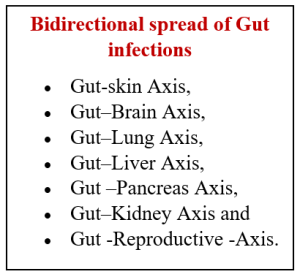
The nerves hidden in the walls of the digestive system is often called as “brain in the gut”. Gut is often called the body’s “second brain.” Scientists call this ‘little brain’- the Enteric Nervous System (ENS). And it’s not so little, the ENS is two thin layers of more than 100 million nerve cells lining the gastrointestinal tract from esophagus to rectum. The eating behavior, hunger contractions and the taste is all controlled by intestine -brain axis.
The Balance of Gut Health. Gut health relies on the maintenance of the delicate balance between the host, the intestinal microbiota, the intestinal environment and dietary compounds. This balance can be significantly affected by factors such as bird management, feed quality and the birds’ environment.
The digestive tract is one of the ecosystems that harbors the largest number and greatest variety of bacteria. Among them, certain bacteria have developed various strategies, including the synthesis of virulence factors such as toxins, to interact with the intestinal mucosa, and are responsible for various pathologies.
A large variety of bacterial toxins of different sizes, structures and modes of action are able to interact with the gastrointestinal mucosa. Some toxins, termed enterotoxins, directly stimulate fluid secretion in enterocytes or cause their death, whereas other toxins pass through the intestinal barrier and disseminate by the general circulation to remote organs or tissues, where they are active.
Similar effects were also observed with the mycotoxin fumonisin. Contamination of poultry feed with 20 mg/kg fumonisin exerts toxic effects on intestinal epithelial cells and induces microbial shift. Fumonisins reduce the length of the small intestine and decrease villus height and crypt depth.
Internal parasites and Coccidial infection also cause severe damage to the intestinal epithelium and the denudated epithelium act as a good medium for bacterial growth.
The difference between Gut Disorders and diseases
Gut Disorder : is characterized by functional impairment and a disruption to the intestinal normal function and structure. Irregularity, disturbance, or interruption of normal functions of the gut. The examples of gut disorders are: Nutritional roup, crop impaction, crop bound, pendulous s crop intussusception etc.
Gut Disease: is a pathological process, enteropathogens in the intestines with a specific cause having characteristic lesions and symptoms.
What is gut inflammation in poultry?
Intestinal inflammation is called as ‘enteritis’ a condition that causes a roughness in gastrointestinal tract, impairing its ability to absorb nutrients and achieve its growth and genetic potential. Intestinal inflammation can occur from several causes such as infection, trauma, fighting, pecking and other environmental factors.
Enteric Diseases: digestive system disease, any of the diseases that affect the digestive tract may affect the esophagus, stomach, small intestine, large intestine (cloaca) caeca , pancreas, liver, or biliary tract. May spread to Kidneys and oviduct.
The viruses, bacteria and internal parasites are the major gents that causes dysbiosis and disturbs the intestinal immune homeostasis. Some of these diseases are the results of secondary infections and may involve respiratory tracts and other organs. Chicken gut is home for more than 100 trillion microorganisms collectively called the gut microbiota, includes bacteria, fungi, protozoa, and viruses. Among these microbes, bacteria play a dominant role in intestinal functions. They are colonized in different segments with vast diversities; they help in digestion, developing the local immunity, and intestinal health.
The major intestinal infectious diseases in poultry. Based on the nature of the causative agent, intestinal infections can be divided into three categories: parasitic, bacterial, and viral diseases (Fig.2).
Fig,2. Common intestinal infectious diseases in poultry. Based on the nature of the causative agent, intestinal infections can be divided into three categories: parasitic, bacterial, and viral diseases. Source: Samiru Wikramsrya et.al 2022)
Bidirectional Spread of poultry Infections
- Gut-Skin –Axis: The microbiome plays an important role in a wide variety of skin disorders. Not only is the skin microbiome altered, but also surprisingly many skin diseases are accompanied by an altered gut microbiome. The microbiome is a key regulator for the immune system, as it aims to maintain homeostasis by communicating with tissues and organs in a bidirectional manner. Hence, dysbiosis in the skin and/or gut microbiome is associated with an altered immune response, promoting the development of skin diseases such as Gangrenous Dermatitis(GDS), streptococcal and staphylococcal infections, Cutaneous Marek’s Disease and Cutaneous Pox.
- Gut- Lung -Axis: In chicken, the most common bacterial genera found in the respiratory are Escherichia, Shigella, Enterococcus, Proteus, Macrococcus, Lactobacillus and Staphylococcus. Emerging evidence has uncovered a cross-communication between the gut and respiratory microbiota, which has been called “the gut-lung axis”. The major infections traverse between gut and lung are Mycoplasma, infectious Coryza, ND, IB, ILT and adenoviral infections.
- Gut -Brain -Axis
The gut–brain axis refers to the bidirectional communication system between the GI tract and the central nervous system; it plays a responsible role in mediating neural, immunological, and hormonal signaling. The role of the gut microbiota in this relationship is crucial because it forms a complex. The complex interacting components of the intestinal system that influence bird’s growth performance and host-microbial homeostasis. The intestines covering dense network with the autonomic nervous system and the enteric nervous system that maintains the homeostatic mechanism which balances the intestinal microflora. The brain controls the peripheral intestinal functions and mechanisms such as immune activation, intestinal permeability, enteric reflex, and entero-endocrine signaling.
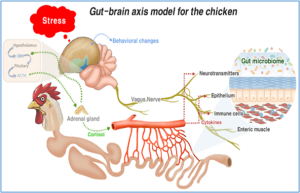
Fig 3. A) Gut-Lung axis and b).Gut-Brain axis (Source: State of the art in research on the gut-liver and gut-brain axis in poultry ) b)Samiru Wikramsrya et.al (2022 )Role of Physiology, Immunity, Microbiota, and Infectious Diseases in the Gut Health of Poultry
4 – Gut-Liver -Axis: The enterohepatic axis represents a close bidirectional relationship between the intestine and the liver. Intestines and the liver communicate via the portal vein and systemic circulation. A healthy liver is a barrier between systemic circulation and the intestines Metabolites produced by the intestines are transported through the portal vein to the liver. At the same time, the liver transports bile salts and antimicrobial molecules to the intestinal lumen through the bile ducts. In this way, it controls the unlimited growth of bacteria. A diseased liver cannot properly inhibit bacterial overgrowth, eliminate harmful by-products, and accelerate regeneration. The liver is also one of the immune organs, activating adaptive and innate immunity mechanisms after exposure to intestinal bacteria in the circulatory system.
Fig .4. Gut-Liver axis (Source: State of the art in research on the gut-liver and gut-brain axis in poultry )
Liver diseases in poultry farming can be caused by both qualitative and quantitative changes in the gut microbiota. The gastrointestinal tract (GI) of chickens contains diverse and complex microbiota which contribute to digestion and absorption of nutrients, immune system development, and pathogen exclusion. The common infections transmit from gut to liver are: Salmonellosis, paratyphoid infections, E.coli, Clostridial infections, Comphylobacteriosis, adenoviral infections, LL and MD.
Fowl adenoviruses (FAdV) in chickens are the etiologic agents of two important diseases known as inclusion body hepatitis (IBH) and hepatitis hydro pericardium syndrome (HHS). A syndrome referred to as gizzard erosion has also been linked to FAdV (especially FAdV-1) in several countries around the globe (fig.6).
Fig 6. Spotty Liver disease of chicken due to Campylobacter hepticus: whitish-gray military spots on the surface of the liver,
Based on electron microscopic examination of feces and intestinal contents. several different viruses also have been identified as causes of gastrointestinal tract infections in poultry. These include rotaviruses, coronaviruses, enteroviruses, adenoviruses, astroviruses, and reoviruses.
In addition, a number of other viruses of unknown importance have been associated with gastrointestinal diseases in poultry. Viral infections of the gastrointestinal tract of poultry are known to negatively impact poultry production, and they likely contribute to the development of other, extra gastrointestinal diseases.
Fig. 6. Inclusion Body Hepatitis and Hepatitis Hydro Pericardium Syndrome in Poultry
Gut- Pancreatic –Axis: Pancreas is unique in its functions, both as an exocrine and endocrine organ as well. While the exocrine pancreas secretes digestive enzymes into the duodenum, the endocrine pancreas is composed of the islets of Langerhans, which contain specialized hormone-secreting cells. These cells include α cells, β-cells, δ-cells, and γ-cells, which secrete glucagon, insulin, somatostatin, and pancreatic polypeptide, respectively. The endocrine pancreas plays a critical role in regulating glucose homeostasis. Adenovirus commonly cause Necrotizing Pancreatitis and Gizzard Erosion in Chickens.
Gut- Renal –Axis: The most common causes of kidney disease in poultry starts from dietary issues. Other, much-less-frequent causes of kidney damage can be certain strains of avian bronchitis, some disinfectants and insecticides, and overuse of some antibiotics such as sulphadrugs,
Fig.7. Gut-Kidney -Axis in spread of infections
There are many causes of kidney diseases and disorders including infections (bacterial, viral, fungal, and parasitic), tumors, heavy metal toxicity, vitamin D toxicity, and other nutritional excesses, metabolic disorders (such as gout), and blockages or obstructions.
Renal Disorder a kind of kidney disease in which there is an inflammation, loss of kidney function and in worst condition led to kidney failure. Urolithiasis, a degenerative renal disease, which is caused by the formation of urolith in the ureters of laying hens. It is also caused when uric acid becomes too high in the bloodstream and kidney is unable to remove that excess uric from the body. With the accumulation of excess toxins in the blood and kidney, the absorption of nutrients from feed lowers which lowers the health and growth.
The nutritional or metabolic causes of gout include- excessive dietary calcium, high protein diet, excess salt, low phosphorus, imbalance between Ca–P levels, adulteration of feed with urea, deficiencies of vitamin A and D, high altitude farming, water deprivation followed by over dosages of certain drugs like sulphas and the antibiotic aminoglycosides often causes kidney damage, managemental stress like, high brooding temperature and higher level of ammonia concentration in the shed can also cause high mortality due to gout, mycotoxins and phytotoxins, poisoning with phenolic disinfectants or insecticides, and infectious causes viz. bacteria (Salmonella, E.coli) and viruses (Infectious bronchitis virus (IBV), avian nephritis virus (ANV) and chicken astro -virus. Bacteria can enter the kidney either by ascending the ureters or by hematogenous spread from gut. In either type of infection, the kidneys may be grossly enlarged with variable degrees of necrosis.
Fatty Liver and Kidney Syndrome (FLKS) mostly affects younger birds; it can be caused by nutritional and metabolic issues; primarily a lack of biotin absorption from the gut.
Fungal infection of the kidney occurs either as an extension of a fungal infection of the abdominal air sacs or as a component of fungemia where a fungus has invaded a vessel, resulting in fungal thrombosis of blood vessels. Fungal hyphae in the lesion give it specificity.
Gut- Oviduct- Axis:
Anatomically the terminal parts of the urinary, reproductive, and digestive systems of birds all connect to the cloaca. As the feces drain through the cloaca of chickens, the cloacal bacteria transmit from the digestive system to oviduct also. The microbiota inhabiting the colon, cloaca, and magnum, is all same.
The Pathogens can transfer from the gut to the oviduct but likely all microorganisms in the gut, including commensals. In poultry. The vertical transmission of gut pathogens from hens to eggs and progeny has been known for some time. Pathogens, such as Salmonella enterica and Campylobacter jejuni, have been shown to colonize the oviduct, thus embedding themselves in the developing egg.
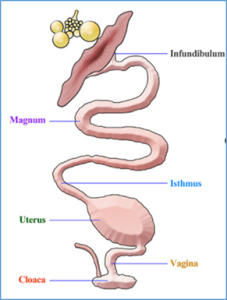
- Fig.8. Oviduct and Ureters empty in to common passage -cloaca While Salmonella enterica serovar Enteritidis may be able to infect the poultry ovary, most Salmonella serovars are thought to colonize the oviduct. Furthermore, Salmonella bacteria can survive the albumen environment of the egg. Hence, a transmission route starting from the gut, passing through the oviduct, on the way to the egg and the chick has been established for pathogens.
Bidirectional Spread of Gut Infections to other Organs in Poultry - Fig.9. Egg Peritonitis forms agood medium for bacterial growth and spread of infection to intestines and other associated organs inside the abdomen
Artificial Insemination ( AI )
AI is commonly practiced in breeder flocs kept in cages. Often this also poses a risk of possible transmission of various infectious pathogens / diseases of poultry through semen or its contamination or during the process of insemination. Hence, careful and regular screening and monitoring of poultry will help to check the spread of such diseases, Infections likely transmit through semen are Infectious bronchitis virus (IBV), avian anaemia virus, leucosis virus, Newcastle disease virus (NDV), Avian rotavirus, Infectious bursal disease virus (IBDV); Escherichia coli, Pasteurella (fowl cholera), Campylobacter, Salmonella, Chlamydia, etc., apart from Sexually Transmitted Microbes (STM’s) during route of fertility, could be transmitted as possible contaminants during AI.
Bacterial Diseases of Poultry gut are:
- Escherichia coli infections.
- Paratyphoid infections.
- Fowl cholera.
- Riemerella anatipestifer infections.
- Necrotic enteritis.
- Cholangiohepatitis in broiler chickens.
Viral diseases of poultry gut are:
Enteric viruses of poultry are common and pervasive. They are potentially responsible for production diseases resulting in substantial financial losses. Many of these viruses have RNA genomes that continually evolve, leading to multiple circulating strains of varying pathogenicity. Viral infections of the gastrointestinal tract of poultry are known to negatively impact poultry production, and they likely contribute to the development of other, extra gastrointestinal diseases.
Several different viruses have been identified as causes of gastrointestinal tract infections in poultry. These include rotaviruses, coronaviruses, en- teroviruses, adenoviruses, astroviruses, and reoviruses.
- Corona viral Enteritis of Turkeys.
- Rotavirus Infections of Poultry.
- Astro-virus Infections in Poultry.
- Chicken Parvovirus and Turkey Parvovirus Infections.
- Picornavirus Infections in Poultry.
- Adenoviruses
- Reo –Viruses
- Calci-viral particles
Diagnosis
Gastrointestinal diseases are common in floor-raised chickens. One way to clinically assess the gastrointestinal health of poultry is to observe their feces. While there are conditions, such as intestinal parasitism, that primarily affect the gastrointestinal tract, conditions of other systems, such as respiratory disease, might present with gastrointestinal signs (e.g., diarrhea). On postmortem examination recognition of typical lesions and serological confirmation, isolation and identification of organisms help in diagnosis.
Conclusions
The GI tract has the most extensive exposed surface in the body, and a wide variety of factors associated with diet and infectious disease agents can negatively affect the delicate balance among the components of the chicken gut. Disturbances in this balance may affect health status and productive performance of birds in commercial poultry operations.
(*Former VC, KVAFSU, Bidar, Former Director, IAH&VB, Bangalore and Former Prof and University Head, Dept. of Pathology, Veterinary College, UAS, Bangalore)
